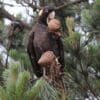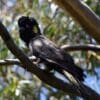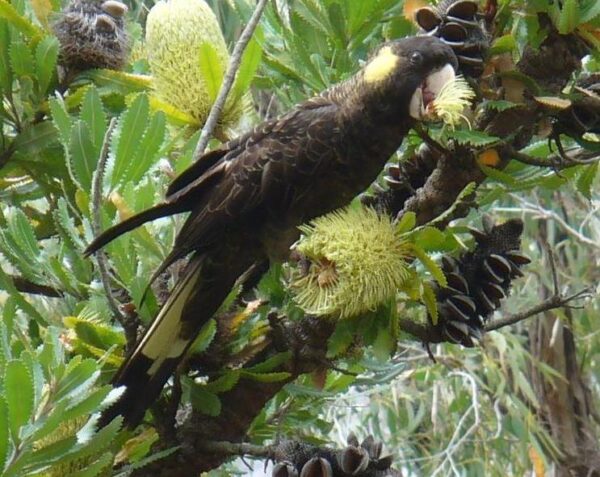Yellow-tailed Black Cockatoo
Also known as:
Black Cockatoo, Funereal Cockatoo, Yellow-eared Cockatoo, Yellow-eared Black Cockatoo, Yellow-tailed Cockatoo, Wylah
Also known as:
Black Cockatoo, Funereal Cockatoo, Yellow-eared Cockatoo, Yellow-eared Black Cockatoo, Yellow-tailed Cockatoo, Wylah

![© David Cook Wildlife Photography [CC BY-SA 2.0] via Wikimedia Commons A wild Yellow-tailed Black Cockatoo perches atop a tree](https://parrots.org/wp-content/uploads/2023/01/wpt_Yellow-tailed-Black-Cockatoo_1434-26-100x100.jpg)
![© Francesco Veronesi [CC BY-SA 2.0] via Wikimedia Commons A wild Yellow-tailed Black Cockatoo perches on a limb](https://parrots.org/wp-content/uploads/2023/01/wpt_Yellow-tailed-Black-Cockatoo_1434-25-100x100.jpg)
















DID YOU KNOW?
The Yellow-tailed Black Cockatoo will brace itself against tree trunks “woodpecker fashion” with their tails while looking for grubs and larvae.

Zanda

funerea
Size:
67 cm (26.1 in)
Weight:
750-900 g (26.2-31.5 oz)
Subspecies including nominate:
two: Z.f. funerea, Z.f. xanthanotus
Colour Adult:
Z.f. funerea: Male-in general brown/black, with feathers finely margined dull yellow; soft yellow ear-coverts; side tail feathers have wide yellow band near tip spotted with brown/black. Beak slate grey. Eye ring pink, eye dark brown. Female-ear coverts bright yellow; tail band more heavily spotted brown/black. Beak horn in colour. Eye ring grey.
Z.f. xanthanotus: Both adults as in funereus but with significantly shorter tail; little brown spotting in yellow tail band, sometimes missing in male; smaller in size.
Colour Juvenile:
As in female.
Call:
In flight a loud unusual lengthy whistle; also harsh alarm notes. Young birds give a constant harsh raspy call.
More Information:
Content Sources:
CITES
BirdLife International
Cornell Lab of Ornithology/Birds of the World
A Guide to Parrots of the World, Juniper and Parr, 1998
Parrots of the World, Forshaw and Cooper, 1989. 2010 edition
Parrots of the World, Forshaw, 2006.
Parrots in Aviculture, Low, 1992.
Guide to Incubation and Handraising Parrots, Digney, 1998.
Captive Status:
Rare in Australia, very rare outside.
Longevity:
May live up to 50 yrs.
Housing:
Walk-in enclosure, minimum length 7 m (23 ft).
Diet:
Nuts including: walnuts, almonds and pine nuts; sunflower seeds, wheat, maize and fresh corn; fresh fruit and green leaves sometimes accepted; peas in the pod; in Australia Banksia and Hakia nuts; complete kibble; when rearing young provide mealworms.
Enrichment:
Are avid chewers so provide with lots of bird-safe wood (fir, pine, Eucalypt, etc), wood blocks, and vegetable tanned leather chew toys.
Nest Box Size:
Open at the top 24″ x 24″ x 48″ (61 cm x 61 cm x 122 cm) vertical box. Provide with branches to provoke chewing and breeding behaviour.
Clutch Size:
1 or 2
Fledging Age:
12-13 weeks
Hatch Weight:
—
Peak Weight:
—
Weaning Weight:
—
World Population:
About 25,000 individuals, stable.
IUCN Red List Status:
Least Concern
CITES Listing:
Appendix II
Threat Summary:
Not globally threatened. Their long-term existence depends on the continued availability of hollow trees for nesting. No subspecies is currently considered to be threatened, and all seem to have adapted to recent alterations in their habitat, namely eucalypt and pine plantations. Is declining in some areas (Eyre Peninsula) but in general the population is stable. Could potentially become more threatened by climate change soon.
Range:
Z.f. funerea: CE and SE Australia from C Queensland south to E Victoria, then west.
Z.f. xanthanotus: Tasmania and SE mainland Australia from C Victoria west to SE South Australia, including Kangaroo Island.
Habitat:
Found in higher rainfall habitat such as coastal areas, Eucalyptus woodlands, pine plantations, heathland, orchards and farmland.
Wild Diet:
Eats seeds of pines, Eucalyptus, Hakea, Casuarina, Banksia and Acacia. Also takes fungus from seed cases and wood-boring larvae which are removed from trunks or roots of trees.
Ecology and Behaviour:
Is reliant on Eucalyptus woodland for breeding; is nomadic, will move between hills and coastland in response to breeding season. Are encountered in large flocks of 300 birds or more; is noisy and conspicuous.
Clutch and Egg Size:
1 or 2 ovate eggs, 50.0 x 34.5 mm (2 x 1.3 in).
Breeding Season:
April-July, N Australia; January-May, N New South Wales; December-February, S New South Wales; October–March, South Australia, Victoria and Tasmania. Nest is bed of chips in large tree hollow.


















